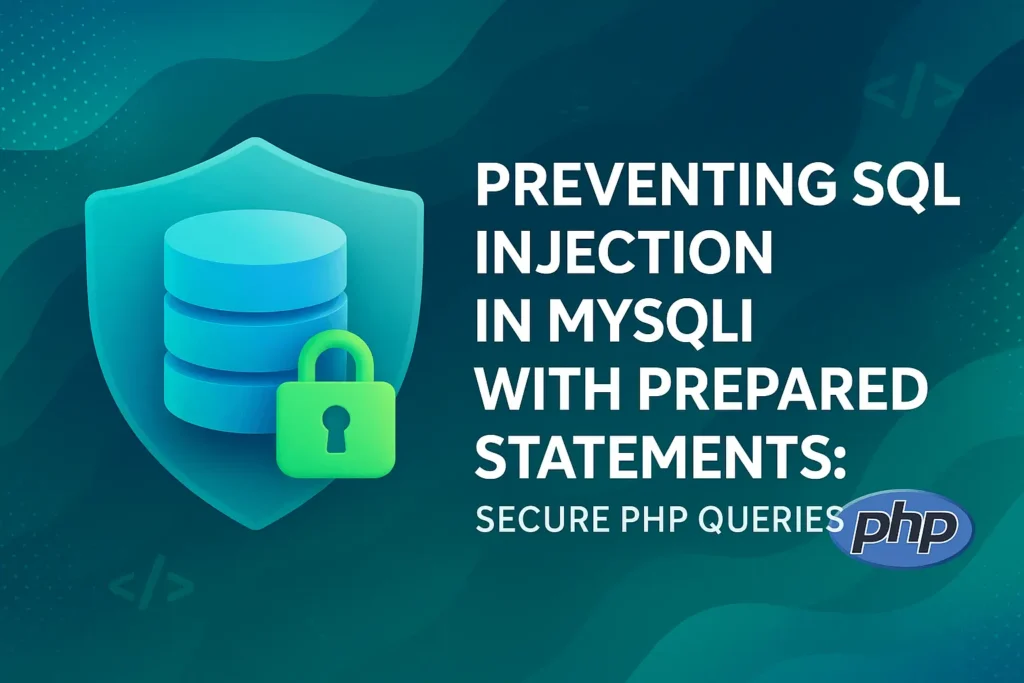Preventing SQL Injection is crucial for ensuring the security and integrity of a web application.
One of the most effective techniques for preventing SQL Injection attacks is the use of prepared statements. In this article, we will explore how to utilize prepared statements with MySQLi in PHP to safeguard against SQL Injection, along with code examples and best practices.
Understanding SQL Injection
SQL Injection happens when an attacker inserts or “injects” malicious SQL code into an input field or URL parameter, which is then executed by the database. For instance, consider a login form that allows users to enter their username and password. If these inputs are not properly sanitized, an attacker could input something like admin’ — into the username field, which might alter the query and bypass authentication. Here’s a basic example of vulnerable PHP code using MySQLi:
<?php
$mysqli = new mysqli("localhost", "user", "password", "database");
if ($mysqli->connect_error) {
die("Connection failed: " . $mysqli->connect_error);
}
$username = $_POST['username'];
$password = $_POST['password'];
$sql = "SELECT * FROM users WHERE username = '$username' AND password = '$password'";
$result = $mysqli->query($sql);
if ($result->num_rows > 0) {
echo "Login successful!";
} else {
echo "Invalid username or password.";
}
$mysqli->close();
?>
In this example, if an attacker enters admin’ — for the username, the resulting query would be:
SELECT * FROM users WHERE username = 'admin' --' AND password = '$password'
The — sequence comments out the rest of the query, effectively bypassing the password check.
Using Prepared Statements to Prevent SQL Injection
Prepared statements are a way to execute SQL queries in a secure manner by separating SQL code from the data being used. Prepared statements ensure that the data is treated as data and not as executable code. This technique helps prevent SQL Injection by binding parameters to the query, thus neutralizing any malicious code in the input.MySQLi Prepared Statements
MySQLi (MySQL Improved) is an extension for PHP that provides an interface to communicate with MySQL databases. It supports prepared statements, which can be utilized to prevent SQL Injection. Here’s how to rewrite the previous example using prepared statements:
<?php
$mysqli = new mysqli("localhost", "user", "password", "database");
if ($mysqli->connect_error) {
die("Connection failed: " . $mysqli->connect_error);
}
// Prepare the SQL statement with placeholders
$stmt = $mysqli->prepare("SELECT * FROM users WHERE username = ? AND password = ?");
// Check if the statement was prepared successfully
if ($stmt === false) {
die("Prepare failed: " . $mysqli->error);
}
// Bind the parameters to the query
$stmt->bind_param("ss", $_POST['username'], $_POST['password']);
// Execute the statement
$stmt->execute();
// Get the result
$result = $stmt->get_result();
if ($result->num_rows > 0) {
echo "Login successful!";
} else {
echo "Invalid username or password.";
}
// Close the statement and connection
$stmt->close();
$mysqli->close();
?>
Breakdown of the Code
- Preparing the Statement: The prepare method creates a prepared statement with placeholders (?). The placeholders represent where user input will be bound in the query.
- Binding Parameters: The bind_param method binds user input to the placeholders. The “ss” parameter specifies the types of the parameters being bound (in this case, both are strings). This ensures that the input is treated as a string rather than executable code.
- Executing the Statement: The execute method runs the query with the bound parameters.
- Fetching Results: The get_result method retrieves the result set from the executed statement.
- Closing Resources: Always close the statement and database connection to free up resources.
Best Practices
- Use Prepared Statements for All Queries: While prepared statements are effective for SELECT, INSERT, UPDATE, and DELETE queries, it’s essential to use them consistently for all database interactions.
- Sanitize User Input: Although prepared statements are robust, it’s still good practice to sanitize and validate user input to avoid other types of vulnerabilities.
- Use Password Hashing: For authentication, avoid storing plain-text passwords. Use hashing algorithms such as bcrypt or Argon2 to securely store and compare passwords.
- Error Handling: Implement proper error handling to avoid exposing sensitive information. Instead of displaying raw errors, log them securely and show user-friendly messages.
- Keep Software Updated: Regularly update your database and PHP libraries to protect against known vulnerabilities and security issues.






